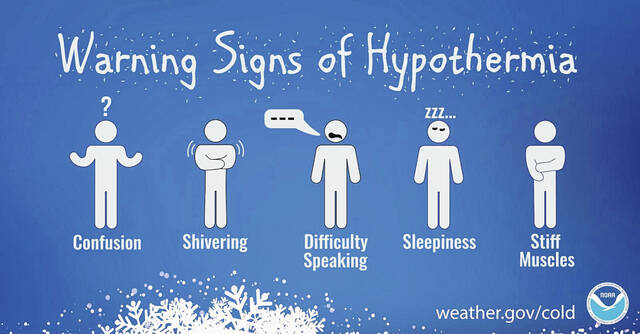
A winter storm is expected to hit Fayette County this week and is forecasted to include ice accumulation and 5-8 inches of snow.
According to www.weather.gov/, “Tuesday through Sunday a potent weather system will impact the area this week. Rain, which may be heavy at times, is expected on Wednesday. This rain will change to freezing rain and sleet on Wednesday night and Thursday, with the potential for heavy accumulations of ice. This will eventually change to snow on Thursday night, with some accumulations possible. Details on the exact timing, and accumulations of ice and snow, are still uncertain. Please monitor later forecasts for updates.”
The National Weather Service provides several tidbits of education on its website in relation to winter weather.
If a watch is issued, get prepared for hazardous weather. If a warning or advisory is issued, take action as hazardous weather is occurring or will occur soon.
When shoveling snow, the National Weather Service advises to push and not lift the shovel, to know the latest forecast, to wear breathable clothes and warm boots, and to drink water.
Freezing rain is not safe. “It is liquid precipitation that freezes on contact with cold surfaces as it enters a shallow layer of temperatures at or below 32 degrees near the surface. This creates a dangerous coating of ice on roads, walkways, trees and power lines,” according to the National Weather Service website.
Freezing rain is more dangerous than snow as ice can form on pavement. Falling branches and powerlines should be watched out for as ice accumulation increases the weight of a span of powerlines by up to 500 pounds and increases the weight of a tree branch by 30 times. Extreme caution should be used if traveling during these conditions.
To prepare for ice storms before they arrive, trim weak or damaged branches around homes, don’t leave vehicle wipers raised, have week’s worth of food and prescriptions, don’t park cars under trees, and keep devices charged.
When it snows, stay off the road if possible. If it is not possible, have an emergency kit in the vehicle, drive slow, do not use cruise control, and be sure to increase distance from other vehicles.
Each year, weather-related crashes cause more than 6,000 deaths and 480,000 injuries. If the outside temperature is near freezing, motorists should drive like they are on ice as ice may be on the roads.
Bridges freeze first for several reasons. There is no ground underneath bridges so cold air can surround the entire structure. Freezing isn’t uniform: shaded parts can be icy while sunny parts aren’t. When driving, slow down before the bridge, because changing speed on ice is dangerous.
Black ice can form on any road, but also along curbs and drainage areas due to melting snow. It is more prevalent at night, but can still be around in the morning. Use caution when driving during freezing temperatures after rain or snow melt.
When power goes out, to help keep warm: close blinds or curtains to keep in some heat, close off rooms to avoid wasting heat, wear layers of loose-fitting and lightweight but warm clothing, eat and drink — food provides energy to warm the body, but avoid caffeine and alcohol, stuff towels or rags in cracks under doors.
Snow Squalls are intense bursts of snow and wind that have a short duration but cause whiteout visibility and rapidly deteriorating road conditions. Snow Squall Warnings are issued when a squall is occurring or imminent. The warning will typically be in effect for 30-60 minutes for a small, targeted area. When issued, it is best to slow down driving or delay traveling.
Even with the bad storms, some people love winter. Here are 10 fun facts about snow, courtesy of the National Weather Service:
—All snowflakes have six sides.
—During the July 1, 1998 to June 30, 1999 snow season, there was 1,140 inches (95 feet) of snow recorded at Mount Baker Ski Area in Washington state.
— The most snow measured in 24 hours was 75.8 inches, which fell in Silver Lake, Colorado April 14-15 in 1921. This is enough to bury most people from head to toe.
—Snow crystals are translucent, not white. The white coloring is caused by sunlight that is reflected off the crystals. All visible colors are reflected which, together, look white.
—Most snowflakes fall at a speed of 2-to-5 feet per second, roughly the same speed as a person casually walking through a park.
—Official snowfall and snow depth measurements include snow, sleep and ice pellets. In the summer, hail will also be recorded as a trace of snow if it is on the ground when the observation is taken.
— A blizzard can occur without falling snow! If wind speeds remain higher than 35 miles per hour and the visibility is also reduced to less than 1/4 mile for three hours or more, then it’s classified as a blizzard.
—A cubic foot of snow (12 inches on a side) may contain between 1 and 2 million individual snowflakes.
—Thundersnow is simply a thunderstorm with snow as the precipitation type. It typically occurs where there is really strong upward motion inside a winter storm.
—All 50 states have recorded snowfall. In Hawaii, snow is observed on the tallest volcano summits every year, and light snow (mainly trace amounts) is an almost yearly occurrence in northern Florida.
Photos taken in relation to the storm can be submitted to the Record-Herald for possible publication by emailing them to [email protected]. Please include names of people and/or pets in the photos.
Reach journalist Jennifer Woods at 740-313-0355.


